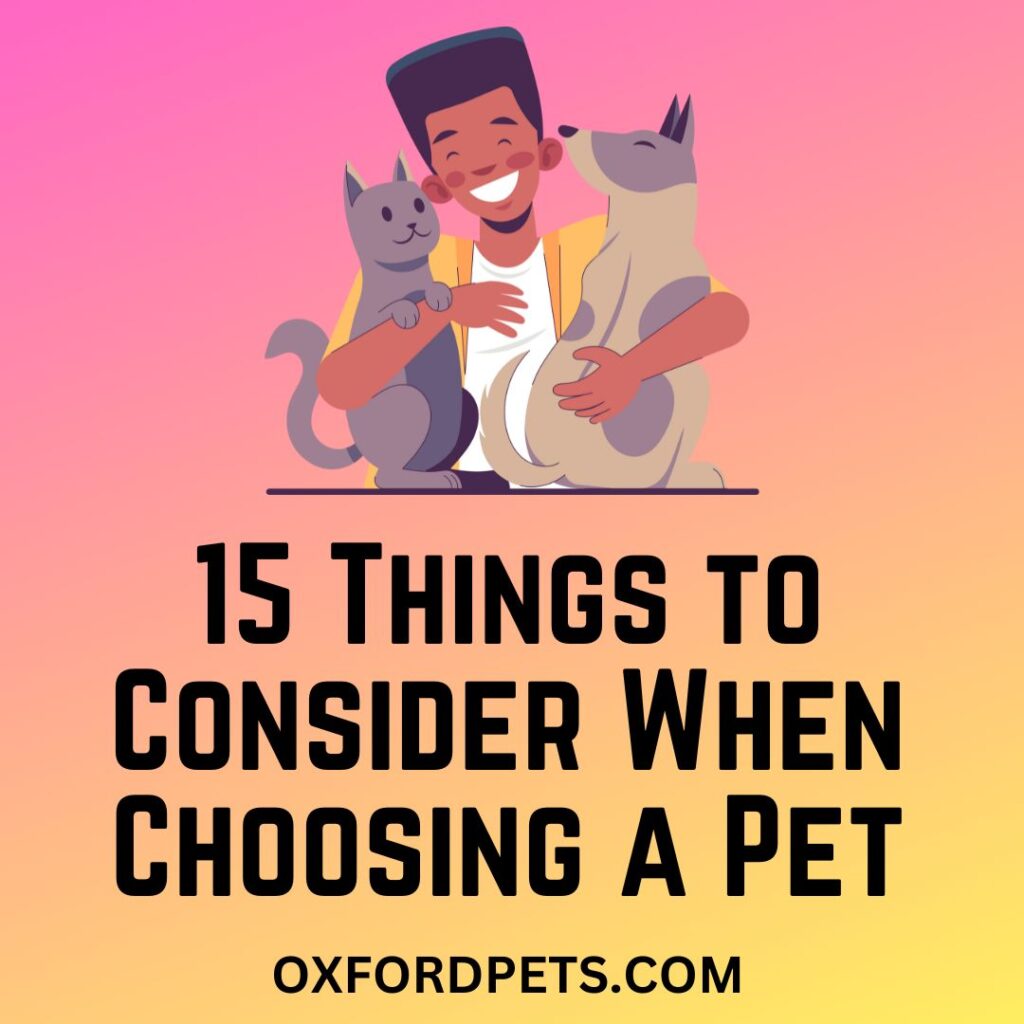Choosing a pet can be an exciting experience, but it also requires careful consideration and research. Before you bring a furry friend into your life, there are some important factors to consider including Lifestyle, Space, Energy levels, Grooming and Dietary Needs, Time Commitment, Exercise needs, Health concerns and many more!
15 Basics to Consider While Choosing a Pet:
- Lifestyle compatibility: Consider whether your lifestyle can accommodate the needs of a pet. For example, if you work long hours and are away from home a lot, a high-maintenance pet like a dog may not be the best choice.
- Size and Space needs: Think about the size of your living space and whether it can accommodate a pet. For example, a large dog may not be suitable for a small apartment.
- Energy level: Consider the energy level of the pet you’re interested in and whether it matches your own. For example, if you’re looking for a low-energy companion, a cat may be a better choice than a high-energy dog.
- Grooming needs: Think about the grooming needs of the pet you’re interested in and whether you’re willing and able to provide that level of care. For example, a long-haired breed like a Persian cat will require more grooming than a short-haired breed like a Siamese cat.
- Dietary requirements: Consider the dietary requirements of the pet you’re interested in and whether you’re willing and able to provide the appropriate food. For example, if you’re a vegetarian, you may not want to choose a carnivorous pet like a snake.
- Noise level: Think about the noise level of the pet you’re interested in and whether you can tolerate it. For example, some bird species like parrots can be very noisy.
- Time commitment: Consider how much time you can devote to a pet and whether you’re willing to make that commitment. For example, a high-maintenance pet like a horse will require more time and resources than a low-maintenance pet like a goldfish.
- Family members: Think about the needs and preferences of other family members, including children and other pets. For example, some dog breeds are better suited to families with children than others.
- Lifespan and Age: Consider the lifespan of the pet you’re interested in and whether you’re prepared for the long-term commitment. For example, some tortoise species can live for over 100 years.
- Temperament: Think about the temperament of the pet you’re interested in and whether it’s compatible with your own. For example, some cat breeds are known for being more independent and aloof, while others are more affectionate.
- Exercise needs: Consider the exercise needs of the pet you’re interested in and whether you’re willing and able to provide that level of activity. For example, a high-energy dog like a Border Collie will require a lot of exercise and stimulation.
- Health concerns: Think about any potential health concerns associated with the pet you’re interested in and whether you’re prepared to handle them. For example, certain dog breeds are predisposed to certain health conditions.
- Travel: Consider how often you travel and whether you’ll be able to bring your pet with you or make other arrangements for their care. For example, if you travel frequently for work, a pet that’s easy to transport like a small dog or cat may be a better choice than a larger animal.
- Cost and Maintenance: Think about the costs associated with owning a pet, including food, vet bills, and supplies, and whether you’re prepared to handle them. For example, a large breed of dog will likely cost more to feed and care for than a small breed.
- Emotional needs: Consider the emotional needs of the pet you’re interested in and whether you’re able to provide the socialization and attention they require. For example, some dog breeds are known for being more social and require a lot of interaction with their owners.

Do you have the right space?
One of the most important things that you should consider before deciding on bringing a pet home is the space. Depending on the pet that you choose, the space you have will determine whether the animal will be comfortable or not.
For instance, if you’re considering adopting a dog, make sure that your home or yard has enough space for them to run around and play in. Similarly, cats may require an area in which they can climb up high and perch, while rabbits will need enough room for them to hop around without bumping into furniture or other obstacles.
Additionally, certain types of birds, such as parrots, may also require special cages with spacious rooms where they can move freely and even fly from one side to another. All in all, when selecting a pet, make sure that your home provides enough space for them so that they can live comfortably and happily.
The breed of the animal you are bringing in as a pet will also dictate how much space you need to have. For example, a Great Dane will have a big problem living in a small studio apartment. On the other hand, a Chihuahua would live more comfortably in the 200-square-foot apartment.
Apart from needing ample space for your new pet to be comfortable, consider the space their other belongings will require. From crates and bedding to toys and supplies, all of these items will need somewhere to go.

The real cost of pet ownership
You’ve probably heard the saying there’s no such thing as a free pet. Sure, you might obtain an animal for free, but there will certainly be costs that will add up in the long run.
From veterinarian bills for having your pet spayed or neutered and vaccinated to cages, collars, leashes and food, the cost of owning and taking care of a pet should be considered before bringing an animal into your home. According to research by ASPCA, the expenses for the first year of owning a pet can exceed $1,000. This is quite expensive if you thought taking care of a pet would be cheap.
Routine visits to your local veterinarian will help ensure that your furry friend is always in optimal health. For instance, if you are a Texas resident, you can consider looking for a vet near you at Humble Texas before settling for a pet. Try to find a vet and schedule a visit as soon as you welcome your new pet into your home. The last thing you want is to be struggling to find a vet in case of an emergency.
As mentioned above, the cost of owning a pet will go beyond just buying it. You will need to factor in food, grooming supplies, pet health insurance, toys, vet visits and more. Depending on the type of pet you get, these costs can vary greatly.
Cats, for example, are generally less expensive than dogs because they require fewer supplies and typically have fewer health issues. However, if you choose an exotic animal like a bird or a reptile, you may need to spend more money on specialized care and housing for them.
Attention and time
You need to understand that your pet will need time and attention. Consider the amount of time you have on hand to cater to the needs of your animal before settling for one. Every pet needs a certain amount of care. This ranges from feeding and cleaning them to giving them love and exercise.
For instance, dogs often require more time for their needs. For starters, you will need to let them out at least twice a day for them to pee and poop. If you get a high-energy dog, you will need to take longer walks or visit nearby parks, which can sometimes be demanding of your time. You also need to account for time to groom them, washing and brushing their fur as needed.
This is why it’s so important that you take into account your own lifestyle and free time before making any decisions.
There are also some questions that you could ask yourself, such as:
- Will you be the one taking care of the pet?
- Will you need to hire a pet sitter or apply for a pet daycare?
- Are you out of the house for long hours?
- Do you travel a lot?
- How much time each day could you realistically spend with your new furry companion?
If you are able to answer these questions, then you will be in a better position to understand the kind of pet that you should have in your household.
Pet Temperament and Personality
One of the vital things to consider when choosing a pet is its personality. Choosing a pet without thinking about its personality might have serious consequences for your bond. First, understand what breed of animal would best work in your household.
For example, there are cats that are comfortable in houses where there are young children. On the other hand, there are those that prefer to lay around and have minimal human contact. Therefore, make sure the personality of the type of pet and breed align with what you’re looking for.
Aim at finding a pet that your family will be comfortable with and will fit in well with your household. You should only take a pet with behavioral issues if you have the professional expertise to handle it.
However, you should also realize that there are some behaviors that develop in pets over time. If this is the case, you should know how to handle them. If not, be ready to call in a professional for help.
Current pet situation
In certain cases, having a second pet is preferable so the animal always has company. Although this is successful in most cases, adopting a new pet into the household may be a source of tension. Not all animals get along, and some may even be territorial and turn aggressive towards another animal.
- Cats and birds – A cat’s natural tendency is to prey on birds, and it is unlikely that it would tell the difference between a domesticated pet bird and a wild one.
- Many sizes of birds – Birds of a smaller size may feel threatened by larger birds, leading them to become aggressive or even self-mutilate as a form of protest.
- Plenty of hamsters and then some – Hamsters are quite possessive of their living space. Bringing a new one into their cage might trigger a battle that could lead to physical harm.
Dealing with allergies to pets
If you or a family member has allergies, you should think carefully before deciding on a pet. Allergies are common among people who have cats and dogs because of their dander and other allergens that collect on their hair or fur. However, if you suffer from allergies, you shouldn’t let that stop you from having a pet. There are numerous hypoallergenic breeds out there that don’t shed as much hair or dander as others do.
If you find your allergies being triggered around your new pet, the Humane Society of the United States has some great tips on dealing with pet allergies, such as reducing the allergens and your symptoms. Overall, the benefits of having a pet usually outweigh the drawbacks of pet allergies.
5 Pros and 5 Cons of owning a pet
Pros:
- Companionship: Pets provide companionship and can be a great source of emotional support and comfort.
- Improved physical health: Owning a pet can lead to improved physical health, as pets require exercise and can encourage their owners to be more active.
- Reduced stress: Spending time with a pet has been shown to reduce stress and anxiety levels, and can help to lower blood pressure.
- Increased socialization: Pets can help their owners to meet new people and increase their socialization skills, especially if they take their pet to public places like parks or dog-friendly cafes.
- Teaching responsibility: Owning a pet can teach children and adults alike about responsibility, as they learn to care for and provide for another living being.
Cons:
- Financial responsibility: Pets can be expensive, with costs associated with food, veterinary care, and other supplies adding up quickly.
- Time commitment: Pets require time and attention, including feeding, grooming, and exercise, which can be a challenge for busy owners.
- Potential for allergies: Some people may be allergic to certain types of pets, which can be a barrier to pet ownership.
- Behavioral issues: Pets can develop behavioral issues that require time, patience, and sometimes professional training to resolve.
- Lifestyle restrictions: Owning a pet can restrict certain aspects of one’s lifestyle, such as travel plans or living arrangements, as not all places allow pets.
Summary
In conclusion, owning a pet is a significant commitment that should not be taken lightly. Before choosing a pet, consider all of these factors to ensure that you are choosing the right pet for you and your family. As a veterinarian, I am happy to provide guidance and answer any questions you may have to help you make the best decision for you and your pet.

